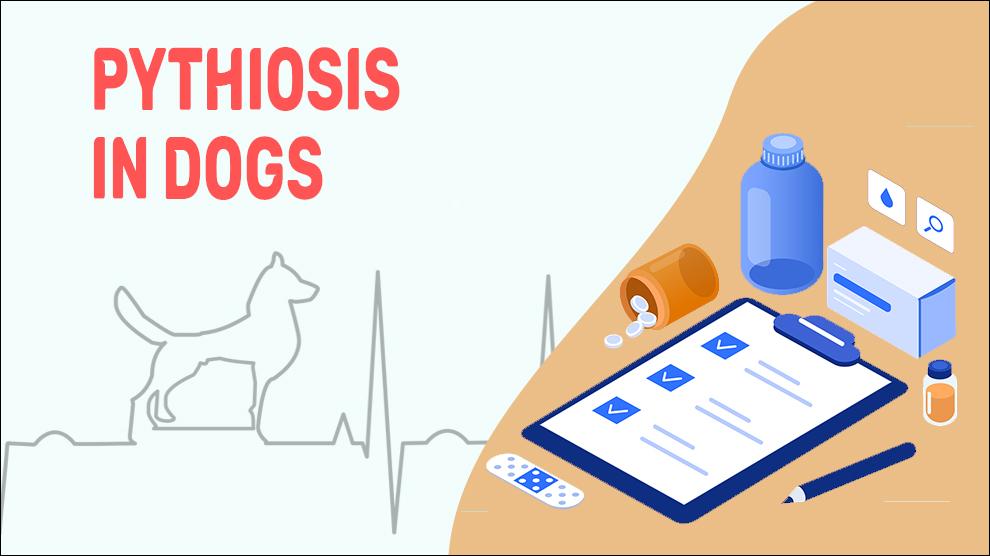The causative agent of pythiosis is fungus-like protists called Pythium insidiosum - an aquatic organism and it is a pseudo fungi (not a proper fungus), but acts to some extent like a fungus. They are called water molds because it thrives in puddle, pools, fish tanks, grasses that grow in stale waters, and even in the soil in enzootic areas.
There are only one species of pythium in the genus of parasitic oomycetes- Pythium insidiosum. This occurs mainly in tropical and subtropical areas and can infect animals and plants, including dogs.
In dogs, the clinical presentation of pythiosis can be broadly grouped into cutaneous, gastrointestinal, vascular, disseminated infections, and other uncommon presentations. The cutaneous form appears when the contaminated water that contains motile zoospores comes in contact with open sores; meanwhile, ingestion of the pathogen causes the gastrointestinal type of pythiosis.
Depending on the underlying immune suppression of the host, the clinical presentation of infection is broad. Usually, canine infections occur when the fungus enters the GI tract via the blood vessels. This will decrease the flow of blood and in due course, block all blood flow to the tissues resulting in chronic pyogranulomatous response in the GI tract, causing extensive damage to the tissues. If not diagnosed quickly and treated properly, the affected dog will die.
Canine lagenidium Vs cutaneous pythiosis: Both are almost similar except dogs that present with lagenidium are progressive to involve distant sites and the multifocal, cutaneous as well as subcutaneous lesions will appear on the trunk, groin, mammary glands, legs, and/or near the tail.
Symptoms Of Pythiosis
Treatment Options For Pythiosis
Commonly used Anti-fungal agents are azole antifungals including itraconazole, fluconazole, voriconazole and ketoconazole. They have relatively few side effects and are well-tolerated by most dogs.
Treatment of pythiosis requires long-term medications.
Amphotericin B (Abelcet -The Liposome Company) is the "gold standard" of antifungal drugs.
Ketoconazole (less expensive than the other azole antifungals) or a combination of medications may also be used in certain cases.
Home Remedies For Pythiosis
- There is no specific home care for pythiosis; this disease requires suitable veterinary care.
- When the proper diagnosis is done, make sure your pet is provided with all prescribed medication.
- Your veterinarian may prescribe the proper food regimen required to keep your pet as healthy as possible.
Prevention Of Pythiosis
- Check the overflowing tanks, and ponds in the backyard carefully.
- When going for walks, keep your dog away from rotting plant matter, dead leaves, and other decayed substances near any water sources.
- Maintain your lawn or garden. Keep it neat and clean to avoid the accumulation of rainwater.
- Feed high-quality food and exercise regularly.
Affected Breeds Of Pythiosis
Large Dog Breeds, Labrador Retriever, Young Dogs
Additional Facts For Pythiosis
1. Causes:
These water molds grow on swampy, stagnant water sources such as ponds, drain water, and reservoirs.
They get easily get transmitted to your dog when they roam outdoors. The protists get attached to their skin and/or fur. The fungus sheds microscopic spores that float in the air to infect a host when inhaled or colonizing organic matter.
Your pet gets infected by inhalation of the fungi spores or by ingestion of contaminated water and other food particles.
2. Types:
Cutaneous pythiosis: Signs include ulcerated skin sores, fistulas (an abnormal passageway in tissues of the body), and wounds that won’t heal. Hairless lesions perforated by draining fistulas are found most commonly on the face, neck, stomach, tail, and legs. Due to these itchy lesions, harm due to self-mutilation is frequent in affected dogs.
Gastrointestinal pythiosis: Clinical signs include diarrhea, weight loss, vomiting and anorexia. The affected dogs are usually asymptomatic and they appear systemically ill only in later stages.
3. Mortality:
If left untreated, the mortality rate of pythiosis is almost 30%. The disease has lethal consequences and despite the best possible treatment protocols, the mortality rate is always higher.
4. Diagnosis:
- Complete blood count (CBC), blood chemistry profile
- Electrolyte panel
- Urinalysis
- A screening blood test called an agar-gel immunodiffusion (AGID) test
- Antigen test (enzyme immunoassay or EIA)
5. Prognosis:
The chances of recovery for dogs with pythiosis are guarded to poor. The outcome is good to some extent if all affected tissues are removed surgically. Treatment with medications alone can only cure less than 10% of dogs.
When To See A Vet
Contact your vet right away, if you notice any of the following:
- Diarrhea, mostly bloody
- Development of nodules/enlarged lymph nodes
- Lesions, ulcerating skin sores, sometimes draining and red
Food Suggestions For Pythiosis
Nutrient-dense, vitamin-rich fruits and veggies
- Legumes, such as lentils, peas, or beans
- Cauliflower, cabbage, broccoli
- Spinach, kale, tomatoes, avocadoes
Plant-based proteins: Peas, chickpeas, lentils
High-fiber foods: whole grain bread, rice, and cereal
Omega 3’s: Tuna, salmon, cod, whiting, whitefish, etc
Conclusion
The prognosis for pythiosis varies inversely with delay in detection, severity, and evidence of GI destruction.
Pythiosis is not contagious; no animal-human or animal-animal transmission has been reported so far.

















